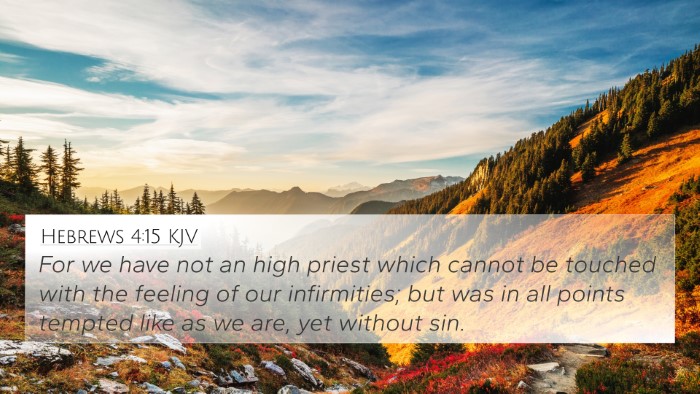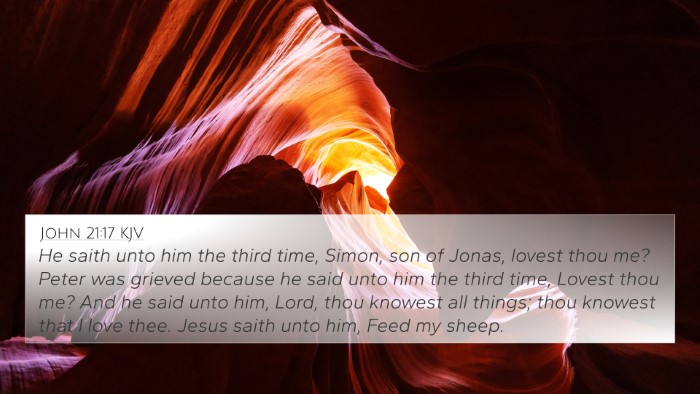Understanding John 5:6
John 5:6: "When Jesus saw him lying there, and knew that he had been now a long time in that case, he saith unto him, Wilt thou be made whole?"
Summary of John 5:6
This verse is part of a larger narrative involving Jesus’ ministry of healing. The scene takes place at the pool of Bethesda, where many ill and disabled individuals gathered, hoping to be healed. Jesus approaches a man who had been infirm for thirty-eight years and asks him a poignant question that goes beyond the physical need for healing; it probes the man’s desire for restoration in a holistic sense.
Commentary Insights
-
Matthew Henry:
Henry emphasizes the compassionate and personal nature of Jesus' inquiry. It demonstrates Jesus' awareness of our conditions, both physical and spiritual. His question invites the man to express his desire for healing and restoration, which is crucial for faith to flourish.
-
Albert Barnes:
Barnes highlights the significance of the man's long-term suffering, suggesting it symbolizes humanity's struggles with sin and affliction. Jesus' question serves not only as a physical inquiry but also suggests a deeper spiritual awakening. It implies the necessity of willingness to receive healing.
-
Adam Clarke:
Clarke interprets this interaction as an illustration of Jesus’ authority and power to restore life. The question posed to the man is pivotal as it reflects the necessity of personal agency in the act of healing. Clarke notes the dualities present in Christ's words where physical healing becomes a metaphor for spiritual salvation.
Thematic Connections
John 5:6 connects numerous theological themes found throughout the Bible:
- Desire for Healing: The idea of wanting to be made whole is prevalent in scriptures where individuals encounter Jesus (e.g., Luke 8:43-48).
- Faith and Willingness: Jesus often emphasizes the need for faith (e.g., Mark 5:34) as a prerequisite for healing.
- Compassion: The compassion of Jesus as a healer (Matthew 14:14) shows His nature and mission on Earth.
- Restoration: The concept of restoration mentioned here relates to passages like Isaiah 61:1-3, where healing and restoration are intertwined with salvation.
- Human Condition: This situation mirrors the struggles present in Psalm 38:3, where the psalmist expresses a profound sense of physical and emotional distress.
- The Nature of Christ: This verse links to the theme of Christ’s miraculous works, as seen in John 2:11 and John 11:43-44, showcasing His divine authority.
- Historical Context of Healing: This event recounts the significance of miraculous healings seen in Acts 3:1-10, expanding the narrative of restoration through faith in Jesus.
Cross-References from John 5:6
- Matthew 8:7: Jesus' authority to heal is highlighted when He responds to a centurion’s request for healing.
- Mark 2:5: The healing of the paralytic illustrates the connection between faith and healing.
- Luke 13:12-13: Jesus heals a woman on the Sabbath, reflecting His compassion and authority.
- John 9:1-7: The healing of the blind man serves as another demonstration of Jesus’ miraculous power.
- John 14:13-14: Jesus speaks about asking in His name, correlating faith with divine intervention.
- Acts 4:30: The apostles’ request for boldness in performing signs and wonders continues the theme of healing through faith.
- James 5:14-15: The scripture emphasizes prayer and faith in healing, correlating with the themes present in John 5:6.
Conclusion
John 5:6 offers profound insights into Jesus' ministry, emphasizing themes of compassion, the desire for healing, and the necessity of faith. It encourages readers to delve deeper into cross-references and thematic connections within scripture, expanding their understanding of the intricate ways in which the Bible speaks to the complexities of the human condition and the divine invitation to wholeness and restoration.









